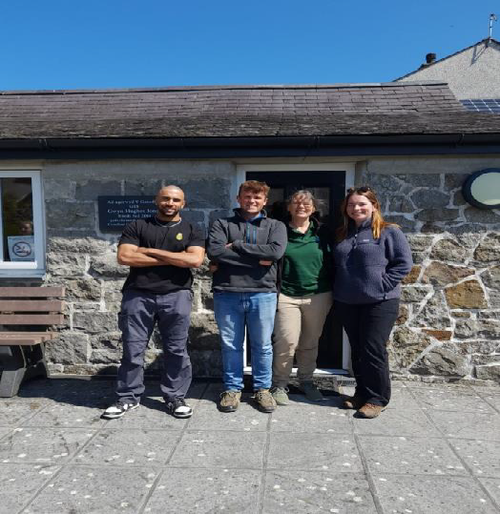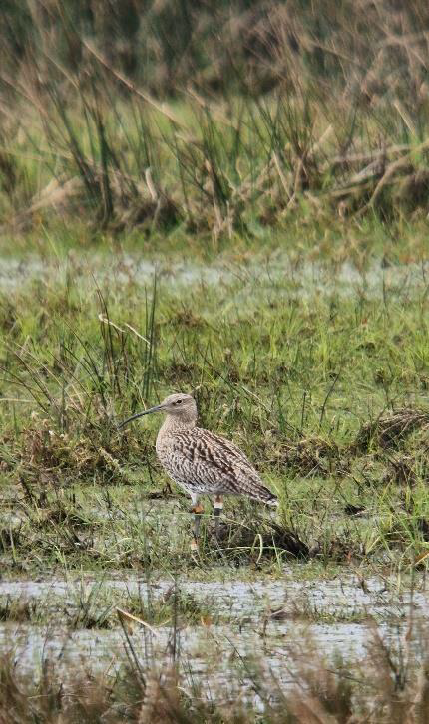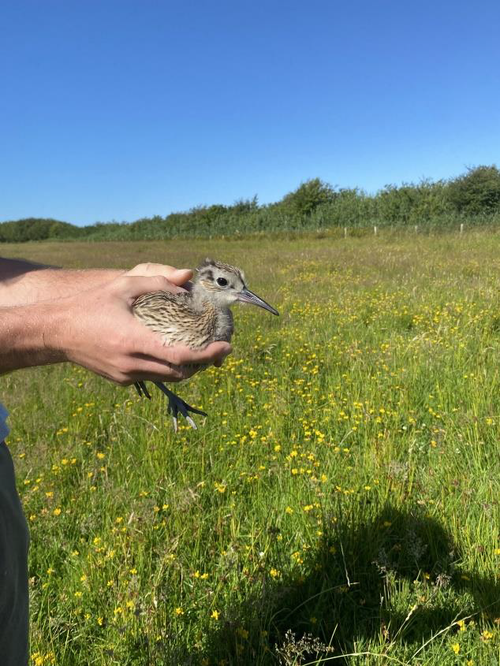
Across Wales, the breeding Curlew population has experienced an 80% decline since the 1990s. Unfortunately, Ynys Môn is no exception. In the 1980s, there were up to 280 breeding pairs of Curlew on Ynys Môn. Now, it is expected that less than 10 dwindling pairs remain.
The last stronghold for Curlew on Ynys Môn is the Cefni Valley, an expansive area of lowland wet grassland which stretches from the Malltraeth Estuary to town of Llangefni. The area is designated as a Site of Special Interest (SSSI) for its botanical features, as well as breeding birds, including Curlew.
Much of the valley has been reclaimed for agriculture and is managed as silage or grazing. However, the RSPB own a considerable amount of land in the area, which is managed as the Cors Ddyga wetland site, one of the largest Lapwing sites in Wales The Curlews in the Cefni Valley predominantly nest off the RSPB reserve on private farmland.

The Curlew population in the Cefni Valley are being supported by RSPB’s Pen Llŷn ac Ynys Môn Project which forms a part of the Natur am Byth! Partnership. Natur am Byth! is a Wales- wide species recovery and people engagement programme, which is principally funded by the National Lottery Heritage Fund, with key support from Welsh Government, Natural Resources Wales and other generous funders.
RSPB’s Natur am Byth team is compromised of five members of staff and a crack team of volunteers. Together, we have spent countless hours in the field finding and protecting nests and liaising with farmers. In addition to Curlew, the team is responsible for the conservation management of 16 other species across Pen Llŷn and Ynys Môn.

By late February, some of our birds had started making an appearance back in the Cefni Valley. Their haunting yet uplifting calls could be heard on foggy early spring mornings. A bird we particular look forward to returning is Vincent. Vincent is a male Curlew who has been nesting in the Cefni Valley since 2018. He was named after a local tenant farmer who used to farm the land where Vincent (the Curlew) nests year on year. It’s like welcoming back an old friend. As 2025 is the second year of project delivery, we entered the breeding season with a head start. Having learnt from 2024, we had an idea of where some of the breeding territories would likely be. However, if you have ever tried to find a needle in a haystack, you’ll know what it’s like to find a Curlew nest.
As we reached May, the team had worked tirelessly and had located seven territories in the valley. Our blueprint for conserving Curlew is simple. Identify the territories, find the nests, erect an electric fence around the nest to prevent ground predators from predating the eggs. Although, ariel attack from avian predators remains as a credible threat.
Then, we work with the farmer by offering financial support to maintain suitable habitat for adult Curlews and chicks. Our aim, to fledge at least 0.5 chicks per pair, enough for the local Curlew population to at least remain stable.
In 2024, we established a good working relationship with some of the farmers in the Cefni Valley. And as a result, saw the fledging of 3 Curlew chicks from 5 pairs. Enough to achieve the 0.5 threshold to maintain a stable population. However, this year, things looked different.
We were unable to construct electric fences around 3 nests, and sadly all twelve eggs succumbed to predation. A real sense of hopelessness filled the team. Electric fencing was constructed around the other nests in the valley, yet still, some were predated at egg stage and others as newly hatched chicks. Sadly, this was a season favouring the predators.
But not all hope was lost. As we headed into June, one pair of Curlews still had two chicks. Over the coming weeks, the team took turns to monitor the chicks. As the days passed by, the chicks grew with strength and confidence. The team was filled with a glimmer of hope. Then, two chicks became one. Our hearts sunk with the realisation that this year’s breeding season could end without seeing a single Curlew chick fledge from Ynys Môn.

As we reached July one chick still persevered. As it neared fledging stage, we caught and colour ring the chick under license so that it could be identified if it fledges. A week later, against all the odds, we could confidently say that the chick had flown its nest. We can only hope now that the chicks we colour ring year after year make their return to their home in the Cefni Valley.
This year has been a tough Curlew breeding season. The birds, and the team, have experience highs and many lows. But if there is one thing that we can learn from this season, it’s that Curlews cannot be saved in isolation. Curlews need collaboration. These birds need a collective effort from farmers, conservationists, foresters and gamekeepers alike if they are to ever to stand a chance in the modern landscape.
Our work in the Cefni Valley would not be possible without the cooperation of the local farming community. And for that, we are extremely grateful to all who have supported the project in any way.